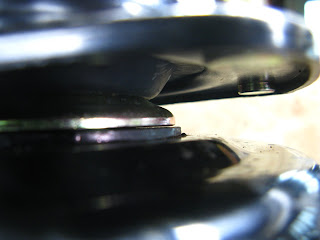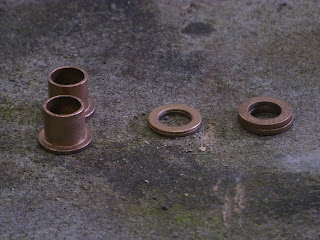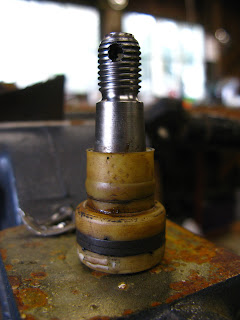
i went to the biggest hardware store in the area and sat down with my calipers at the bronze bushings and came up with this assortment. the pin measurements were .986" for the OD (the cavity size, actually 25mm) and an ID range of .536" - .636" (the taper). so thats basically 1 x 5/8". they only had two thicknesses (1/16 and 1/8) and they were $2.50 each, so i tried to get only what i needed for one side. i think it came out to around $25 because i used so many thin ones...
the process of sanding/grinding each washer down to the right diameter is incredibly tedious. luckily its not a lot of material to remove, but it does take a lot of care to keep a perfect circle. i made a crude mandrel out of a BMX axle and an old suspension bushing and put it in the drill press:
the ID was sized with a dremel tool using a 60 grit sanding drum. i used the largest size that would fit inside the original 5/8" hole...that kept the out-of-roundness to a minimum. this is my first batch. later versions had one more 1/16" washer and a beveled edge on top for a tighter fit:
assembled (as above) with 1" snapring:
this setup resulted in nearly 1/16" /0.060" of lateral play and nearly as much axial, so something was clearly not right. i started to feel like a chump for cutting apart a perfectly tight, sealed joint just to replace some nylon that might have cracked in another 20 years. it seems to me that by "solving" the nylon problem you just create a new one: sloppy pins.
out of morbid curiosity i decided to spend the rest of the day trying to make a new cap out of some tin flashing i found in the basement.
here you can see some of the early attempts behind the final draft:
most of that shape was thanks to another obscure bicycle suspension tool i had lying around. i'm not even sure what it was for originally, but it served as a perfect anvil:
the rest of the final shape was achieved with a small ball-peen hammer, a socket, and the head of the pin itself:
there are a couple issues i have with the cap...first, ideally it would be the same size (OD) as the groove that the circlip fits in so that it stays centered and covers everything. but it has to be smaller than that to fit past the opening (so basically the diameter of the cavity, or 25mm) and as a result its a loose, wandering fit:

the other thing is that the dome size is just barely smaller than the opening, so it interferes with the ears of the circlip. also, i dont see how this would be any less susceptible to moisture issues without dipping the whole thing in plasti-dip or permatex...
in the end i made multiple versions to try and find just the right combination that would give a tight joint and never really found it. i did take a break from the internal parts and work on the external, tapered ones for a while. this was pretty straightforward...only one diameter to worry about and all i needed to do was keep stacking until it was the same as the gap i had measured with the arm torqued on. it was so close to 1/2" that i just took the last washer and sanded one face of it flat on the bench til it was right, then tightened the arm on to force them all together:
i'm not totally sure about this part either, so i may redo one or two of the washers to get the stack height right.
so after $60 in bronze washers and dremel parts and 3 days slumped over the vice all ive got is a really sore back. i dont think i'm going to do this to the NOS centerlink. i'll make a bushing for the gap, but not the insides. i just dont see how its an improvement.

















































